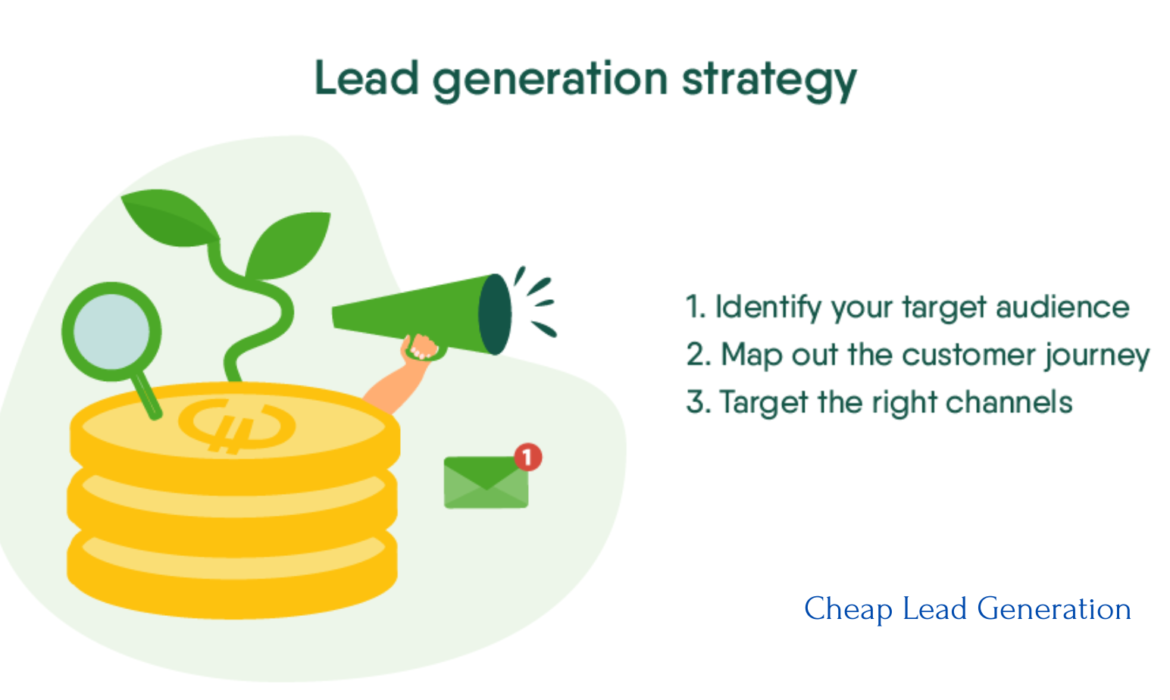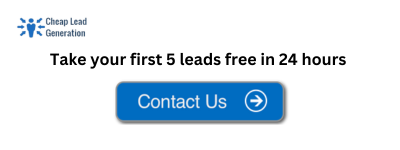Are you struggling to generate high-quality leads for your B2B business? Are you tired of traditional marketing methods that yield lackluster results? Well, fret no more! In this ultimate guide, we will unveil the secrets to mastering the art of B2B lead generation. From social media marketing and email campaigns to content creation and SEO strategies, we’ve got you covered. So get ready to boost your sales and grow your business like never before! Let’s dive in and discover the proven techniques that will revolutionize your lead generation game plan.
Understanding Your Target Audience
To master B2B lead generation, it is crucial to have a deep understanding of your target audience. This involves going beyond basic demographics and delving into their pain points, challenges, and motivations. By gaining insights into their needs and desires, you can tailor your marketing efforts to effectively reach them.
Start by conducting thorough market research. This includes analyzing industry trends, competitor analysis, and customer feedback. Use this information to create buyer personas that represent different segments of your target audience.
Once you have identified your target audience, develop a messaging strategy that resonates with them. Craft compelling content that addresses their pain points and offers solutions. Personalize your communication to show that you understand their specific challenges.
Utilize data analytics tools to track customer behavior and engagement metrics. This will help you refine your targeting strategies over time based on real-time insights. Experiment with different channels such as social media platforms or email campaigns to determine which ones yield the best results for reaching your audience.
Remember, understanding your target audience is an ongoing process. Stay updated on industry changes and continuously gather feedback from customers to refine and improve your approach. By keeping tabs on evolving preferences and behaviors, you can optimize lead generation efforts for maximum impact.

Creating a Solid Value Proposition
When it comes to B2B lead generation, one of the key elements that can make or break your success is having a solid value proposition. In basic terms, your value proposition explains why prospective customers should choose you over your competitors.
To create a strong value proposition, start by understanding the pain points and needs of your target audience. What problems are they facing? How can your product or service solve those problems? By identifying these pain points, you can tailor your value proposition to address them directly.
Next, focus on highlighting the specific benefits that customers will gain from choosing your solution. This could include cost savings, increased efficiency, improved productivity, or any other tangible results that align with their goals.
Another important aspect of creating a solid value proposition is clearly articulating how your product or service differs from others in the market. What makes you unique? Is it superior quality, advanced technology, exceptional customer service? Highlighting these differentiators will help position yourself as the preferred choice for potential customers.
In addition to focusing on what makes you stand out, ensure that your value proposition resonates with the emotions of your target audience. A person’s decision is strongly influenced by their emotional needs as well as logic.
Craft a straightforward value proposition for B2B lead generation. Avoid technical jargon and complexity. Use clear language to convey the benefits of choosing your solution.
A tailored value proposition for B2B lead generation sets you apart and boosts sales, fostering business growth in today’s competitive market
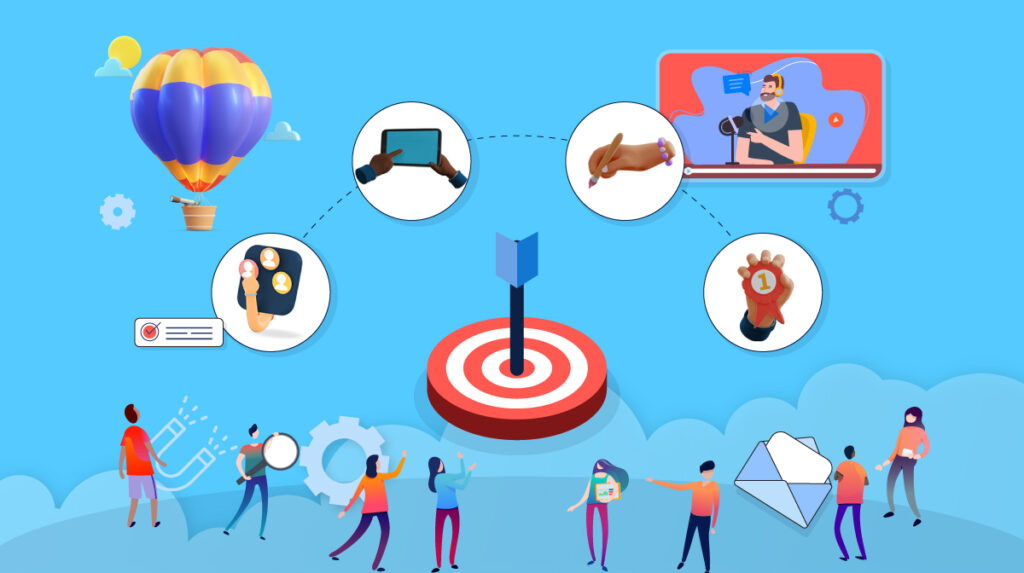
Utilizing Various Channels for B2B Lead Generation
When it comes to B2B Lead Generation, using multiple channels is key to reaching a wider audience and maximizing your chances of success. Gone are the days when cold calling or email blasts were enough. Today, businesses need to be present where their target audience is.
One effective channel for lead generation is social media. Platforms like LinkedIn and Twitter allow you to connect with potential leads directly and establish valuable relationships. By sharing informative content, engaging in industry discussions, and showcasing your expertise, you can attract interested prospects who may eventually become customers.
Another powerful tool in your arsenal is content marketing. Creating high-quality blog posts, videos, whitepapers, or webinars that address your target audience’s pain points will not only position you as an authority but also generate leads through organic search traffic and referrals.
Email marketing remains a tried-and-true method for nurturing leads over time. By offering valuable resources such as eBooks or exclusive discounts in exchange for contact information, you can build a database of qualified prospects eager to hear more from you.
Don’t underestimate the power of events either! Participating in trade shows or hosting webinars allows you to engage with potential clients face-to-face (or virtually) while giving them a taste of what your business has to offer.
Consider partnering with influencers or industry experts who have already built trust among your target audience. Collaborating on co-branded content or sponsoring their podcasts can give you access to new leads who are more likely to convert due to the endorsement they receive from someone they trust.
By utilizing various channels strategically and consistently monitoring their effectiveness through analytics tools like Google Analytics or HubSpot’s tracking features ,you’ll be able to fine-tune your approach over time and optimize results.
Social Media Marketing
Social media has become an integral part of our daily lives, and it’s also a powerful tool for B2B lead generation. With billions of active users on various platforms like Facebook, LinkedIn, Twitter, and Instagram, social media marketing can help businesses reach a wide audience and generate quality leads.
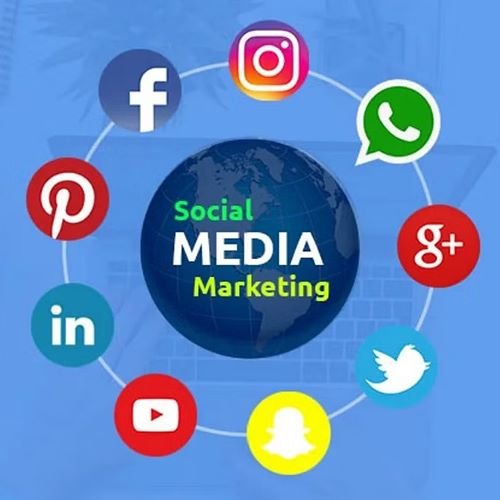
One of the key advantages of social media marketing is its ability to target specific demographics. This means that you can tailor your content and ads to reach the right audience based on factors such as age, location, job title, or industry. By doing so, you can ensure that your message resonates with potential leads who are most likely to be interested in your products or services.
Social media platforms offer engagement tools beyond targeting. Share industry-related blog posts to showcase thought leadership and interact with followers through comments and messages to build relationships with potential leads.
Social media marketing is cost-effective compared to traditional advertising. Careful planning and strategy can yield high-quality leads at a fraction of the cost.
To get the most out of your social media efforts for lead generation purposes:
1) Define clear goals: Determine what exactly you want to achieve through your social media campaigns – whether it’s brand awareness, website traffic increase or lead generation.
2) Choose the right platforms: Research which social media platforms are popular among your target audience and focus on those.
3) Create valuable content: Share helpful information related to your industry that will resonate with potential leads.
4) Consistency is key: Regularly post updates and engage with followers consistently.
5) Track metrics: Learn what works best to generate leads by monitoring analytics data provided by each platform.
Incorporate effective B2B lead generation strategies into your plan, and watch social media marketing drive significant business growth. Don’t miss out—capitalize on it.
Email Marketing
Email marketing is a powerful tool in the B2B lead generation arsenal. It allows businesses to connect directly with their target audience, delivering tailored messages and personalized content straight to their inbox. But it’s not just about sending out mass emails and hoping for the best – successful email marketing requires strategy and careful planning.
One of the first steps in effective email marketing is building a quality subscriber list. This involves capturing leads through various channels such as website sign-up forms, social media campaigns, or even offline events. The key here is to attract individuals who are genuinely interested in your product or service.
Once you have a solid list of subscribers, it’s time to create compelling and engaging email content. Personalization is essential – addressing recipients by name and tailoring the message based on their preferences helps establish a connection and increases open rates. Providing valuable information, offering exclusive deals or discounts, or sharing industry insights can all help keep your audience engaged.
Segmenting your email list based on demographics, interests, and behavior allows for more targeted campaigns. Monitoring metrics like open rates, CTRs, conversions, and unsubscribes offers insights to improve your email strategy.
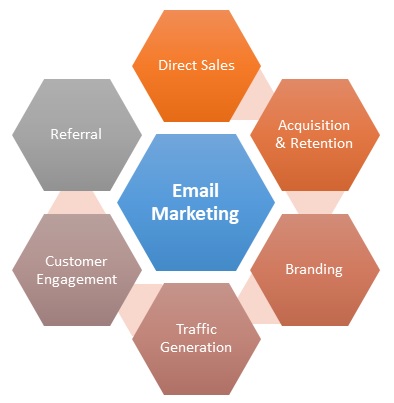
Remember that consistency is vital when it comes to email marketing. Regularly sending out informative newsletters or updates keeps your brand top-of-mind while also establishing trust with your audience over time.
In conclusion: Email marketing is vital for B2B lead generation. Personalized messages to quality subscribers, engaging content, segmentation, and metrics analysis enhance campaign effectiveness.
Content Marketing
Content Marketing is an essential component of any successful B2B lead generation strategy. With the ever-increasing amount of information available online, businesses need to create valuable and engaging content that attracts and educates their target audience.
One of the most effective ways to generate leads through content marketing is by creating high-quality blog posts. By consistently publishing informative articles that address pain points and provide solutions for your ideal customers, you can establish yourself as a thought leader in your industry. This will not only attract potential leads but also build trust and credibility with your audience.

Another powerful content marketing tool for lead generation is producing educational videos. Video content allows you to showcase your expertise, demonstrate product features, and engage viewers on a deeper level. Whether it’s hosting webinars or creating tutorial videos, incorporating video into your content strategy can significantly increase brand awareness and capture valuable leads.
Additionally, eBooks and whitepapers are great resources for capturing contact information from interested prospects. By offering downloadable guides or reports in exchange for email addresses or other contact details, you can effectively nurture these leads through targeted email campaigns.
Don’t forget about infographics! Visual content like infographics can help simplify complex concepts while still providing value to your audience. Infographics are easily shareable on social media platforms which amplifies their reach potential even further.
When it comes to B2B lead generation strategy, leveraging the power of content marketing is crucial. By creating informative blog posts, videos, eBooks, and infographics, you’ll be able to attract a qualified audience who are genuinely interested in what you have to offer.
And remember, content marketing should always be focused on providing value rather than just promoting products or services.
SEO and PPC Advertising
SEO and PPC advertising are two powerful strategies that can greatly enhance your B2B lead generation efforts.
When it comes to SEO, optimizing your website for search engines is crucial. This involves conducting keyword research to identify the terms and phrases potential customers are using to find businesses like yours. By incorporating these keywords into your website content, meta tags, and URLs, you can improve your organic search rankings and attract more qualified leads.
On the other hand, PPC advertising allows you to display targeted ads on search engine results pages or other websites in exchange for a fee each time someone clicks on your ad. This method provides instant visibility and immediate results by placing your brand in front of potential customers who are actively searching for products or services related to what you offer.
Both SEO and PPC require ongoing monitoring and optimization to ensure optimal performance. Analyzing data such as click-through rates, conversion rates, and cost-per-acquisition will help you refine your campaigns over time for maximum ROI.

By leveraging both SEO and PPC together in a coordinated strategy, you can effectively increase visibility, drive traffic to your website, generate high-quality leads, and ultimately boost sales for your B2B business.
Developing a Lead Scoring System
Once you have generated a pool of leads, it’s important to prioritize them based on their potential value. This is where developing a lead scoring system comes into play. A lead scoring system allows you to assign points or scores to each lead based on criteria such as demographics, behavior, and engagement level.
By implementing a lead scoring system, you can identify the most qualified leads and focus your efforts on nurturing them further down the sales funnel. This helps ensure that your sales team spends their time and resources efficiently, resulting in higher conversion rates and increased revenue.
To create an effective lead scoring system, define relevant criteria, like job title, industry, website activity, and more. Assign scores based on their importance in predicting conversions. Continuously refine your system as prospect behaviors and market dynamics change.
Utilize machine learning tools to predict high-converting leads. Keep in mind that lead generation is an ongoing process; use analytics for data-driven campaign optimization.
In conclusion,
Lead scoring is an essential component of any successful B2B lead generation strategy. By assigning values to each lead based on their behavior and characteristics, you can prioritize your efforts and focus on the most promising prospects. As we conclude our discussion on developing a lead scoring system, let’s recap some key points.
Collaborate with your sales team to define lead-scoring criteria. Use technology for automation, like CRM or marketing platforms, to track data and identify high-value leads in real time. Continuously refine your scoring model based on performance, and evaluate its effectiveness by analyzing conversion rates and sales outcomes for improved lead generation.
Nurturing Leads through the Sales Funnel
Once you’ve generated leads for your B2B business, the next step is to nurture those leads through the sales funnel. This involves building relationships with your potential customers and guiding them towards making a purchase.
Lead nurturing starts with awareness; provide valuable content like blog posts and webinars. As leads move to the consideration stage, offer case studies and testimonials to show how your product can help them.
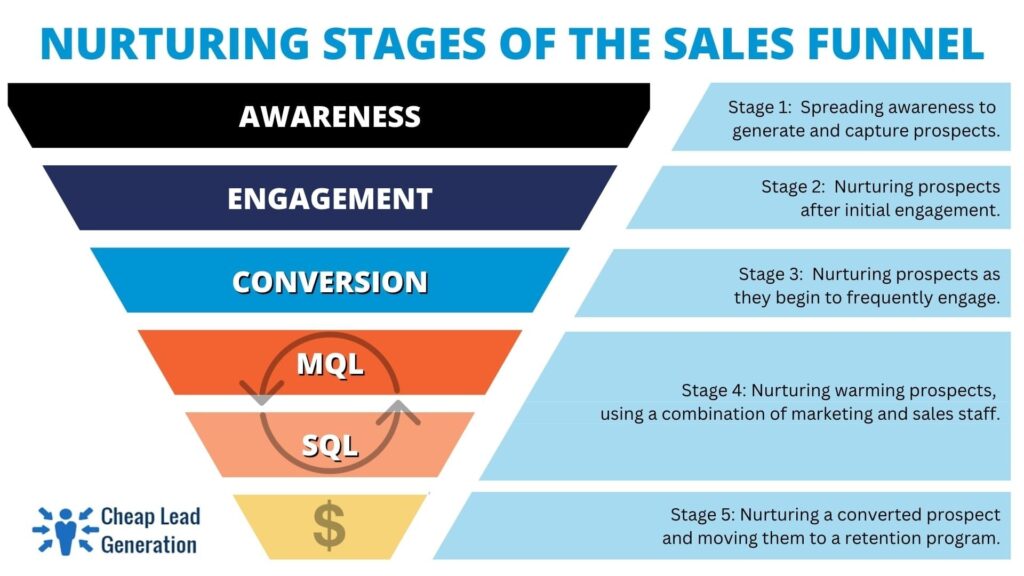
In the decision stage of the sales funnel, it’s crucial to provide personalized and targeted information that addresses any concerns or objections prospects may have. This could include offering a free trial or consultation to showcase the value of your offering.
Throughout each stage of nurturing leads, it’s essential to maintain consistent communication via email marketing campaigns or social media interactions. By providing relevant and timely information based on their specific needs and interests, you can build trust and credibility with potential customers.
Remember that lead nurturing is an ongoing process that requires continuous monitoring and adjustment based on feedback from prospects. By understanding their pain points and addressing them effectively at each stage of the sales funnel, you increase your chances of converting leads into loyal customers.
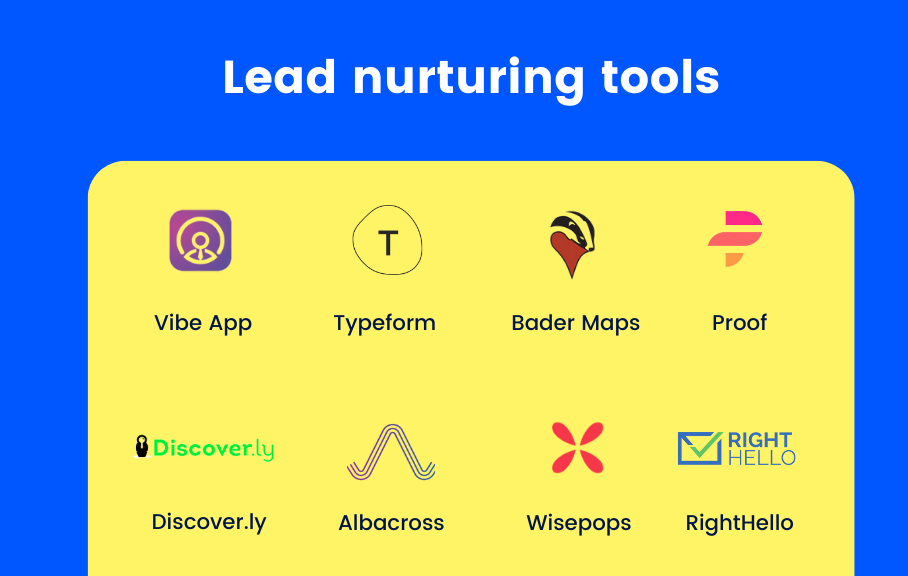
Success in nurturing B2B leads relies heavily on understanding buyer behavior patterns within different industries as well as leveraging automation tools for efficient lead management. Take advantage of CRM systems like Salesforce or HubSpot which enable seamless lead tracking while integrating various marketing channels for maximum impact.
In summary, nurturing B2B leads requires consistency, content relevancy, and personalization throughout every touchpoint in order optimize conversions. With a well-defined strategy and the right tools in place, you can nurture.
Measuring and Analyzing Results
Measuring and analyzing the results of your B2B Lead Generation efforts is a crucial step in optimizing your strategy. It allows you to gain valuable insights into what’s working and what needs improvement. One key metric to track is conversion rate – how many leads actually convert into customers? By monitoring this, you can identify any bottlenecks or areas for optimization within your sales funnel.
Another important aspect to measure is the quality of leads generated. Are they qualified prospects who are likely to become paying customers? Look at factors such as lead source, demographics, and behavior patterns to determine if you’re attracting the right audience.
Additionally, don’t forget about tracking engagement metrics like click-through rates, email open rates, or website traffic. These indicators provide valuable feedback on the effectiveness of your messaging and content.

To analyze these results effectively, use tools like Google Analytics or CRM systems that offer robust reporting capabilities. Dig deep into the data and look for patterns or trends that can inform future marketing decisions.
Remember, measuring and analyzing results should be an ongoing process. Continuously monitor your metrics and make adjustments as needed to optimize your lead generation strategy for maximum success!
Common Mistakes to Avoid in B2B Lead Generation
In the world of B2B Lead Generation, there are many pitfalls that businesses can fall into. These mistakes can hinder your efforts and prevent you from achieving success. In order to generate high-quality leads, it’s important to avoid these common errors.
One mistake is not having a clear target audience or ideal customer profile. Without this clarity, your marketing efforts will lack focus and may not resonate with the right people. Take the time to define your target audience and understand their pain points, needs, and preferences.
Another common mistake is relying solely on one lead generation channel. While it’s great to have a go-to strategy that works for you, it’s important to diversify your approach. Get more leads by utilizing social media advertising, content marketing, email campaigns, and webinars.
Neglecting the importance of nurturing leads is another blunder many businesses make. Just because someone has shown initial interest doesn’t mean they’re ready to buy immediately. Personalization and targeted content are key components of an effective lead nurturing strategy.
Additionally, failing to track and analyze data is a grave mistake in B2B lead generation. Data provides valuable insights into what tactics are working well and where improvements can be made. Using Google Analytics or CRM systems to track metrics such as conversion rates and website traffic sources.

Lastly but equally important is not aligning sales and marketing teams effectively. Collaboration between these departments ensures smooth handoffs from marketing-qualified leads (MQLs) to sales-qualified leads (SQLs). Establish open lines of communication between both teams by setting up regular meetings or using collaboration software.
If you avoid these common B2B lead generation mistakes, you’ll get more qualified leads and boost your company.
Case Studies: Successful B2B Lead Generation
Case studies are like golden nuggets in the world of B2B Lead Generation. They provide real-life examples of successful strategies and tactics that have yielded impressive results. By studying these case studies, you can gain valuable insights into what works and what doesn’t when it comes to generating leads for your business.
One such success story is the case study of Company X, a B2B software provider. They were struggling to attract qualified leads and convert them into customers. After conducting thorough market research, they identified their target audience and developed a highly targeted content marketing campaign.
Through strategic content creation and distribution, Company X was able to position themselves as industry leaders and thought influencers, attracting high-quality leads who were genuinely interested in their products. Their lead generation efforts resulted in a staggering 200% increase in sales within just six months!
Take inspiration from Company Y, a B2B digital marketing specialist. Their personalized email strategy, using segmentation and automation, boosted open rates, CTRs, and conversions. These cases show the value of addressing audience pain points with tailored campaigns and efficient tech.
In conclusion
The key takeaway from these successful case studies is that there is no one-size-fits-all approach when it comes to B2B lead generation. Each business is unique with its own set of challenges and opportunities. However, by studying successful case studies like these ones mentioned above, you can gain valuable insights into effective strategies that may work for your specific industry or niche.

